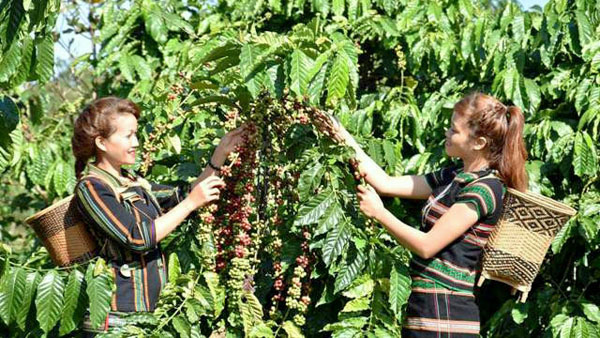


|
Locals in Dak Lak province enjoy a good crop of coffee beans. (Credit: NDO) According
to the Steering Committee for the Central Highlands, bringing into play its
advantages in terms of land, climate and production experiences, the Central
Highlands has developed coffee farming into a specialised cultivation area,
contributing to helping Vietnam become the second largest producer and
exporter of coffee in the world, leading the production and export of robusta
coffee.
Currently,
the region has a total coffee producing area of over
Thanks to
such efforts, the region’s coffee yield is at around 2.35-2.5 tonnes of
coffee beans per ha or more, reaching an annual output of approximately 1.3
million tonnes of coffee beans. According to experts, the region is
considered a specialised cultivation area with the highest coffee yield in
the world.
In recent
years, local coffee farmers have been investing in replacing aging and
ineffective coffee farms with new, economically viable, coffee varieties,
such as TR4, TR5, TR6, TR7, TR8, TR9, TR11, TR12, and TR13. At the same time,
they plant shade trees and windbreakers in coffee gardens to combat climate
change.
A
Vietnamese good agricultural practice (VietGap) on coffee trees is also being
employed, with tens of thousands of farmers participating in sustainable
coffee production. Coffee production programmes are certified according to
the code of UTZ Certified,
In
addition to coffee trees, the provinces of the Central Highlands also have
long-life industrial crops of high economic value, such as pepper trees with
a total area of over
However,
agricultural development across the region in general, as well as the
development of long-term industrial crops in particular, has not yet met the
regions potential. Agriculture is still fragmented, with low quality and
value, while major agricultural products such as coffee, pepper, rubber, and
cashew nut are mainly raw exports, leading to a low added value and incomes
for local farmers.
Tay Nguyen has great potential for development of many kinds of
industrial crops. (Credit: NDO) Apart
from objective reasons, such as climate change which drastically increases
abnormal drought and flooding that cause severely negative impacts on
agricultural production, the subjective reasons are that policy mechanisms
have not been properly adjusted on a par with production practices,
especially the policies on land, investment and credit for agricultural
development.
In
addition, the prevalent situation is that management and use of agricultural
land is not under planning, especially the planning for growing coffee and
pepper. According to the plan approved by the Ministry of Agriculture and
Rural Development (MARD), by 2020 coffee cultivation area in the region was
targeted at about
At a recent
workshop on agricultural development in the Central Highlands, held in Buon
Ma Thuot city, Politburo Member To Lam, who is also Minister of Public
Security cum Head of the Steering Committee for the Central Highlands, has
instructed the MARD, the Ministries of Planning and Investment and Science
and Technology, relevant banks and the People's Committees of provinces in
the region, to develop favourable support programmes and assistance
mechanisms, as soon as possible, to build a number of agricultural production
and business models linked with hi-tech application.
Businesses
have been asked to play a key role in bringing the region’s key commodities
(coffee, pepper, cocoa, cashew nuts, etc…) into the local and global value
chain. The MARD and the Ministry of Planning and Investment, as well as other
relevant ministries and agencies, are responsible for designing agricultural
research and development programmes for the Central Highlands, with
synchronous aspects on management, mechanism, market and technology.
In
addition, the planning of planting areas and agricultural production areas
should be associated with farmer and market organisations, connecting them
with modern technology and creating organic agriculture for the Central
Highlands.
The
Central Highlands localities should pay attention to the management of
agricultural land use in accordance with master plans to avoid any disruption
to the planning of key crops, in order to contribute to the sustainable
development of the Central Highlands.
Tay
Nguyen consists of five provinces, namely Dak Lak, Gia Lai, Kon Tum, Dak Nong
and Lam Dong, with 2 million ha of agricultural land (including over
|